
(a)
Interpretation: The structures of the final products formed in the following reactions are to be stated.
Concept introduction: Organic compounds are synthesized through organic reactions. The different types of reactions in
To determine: The structure of C5H12.
(a)
Explanation of Solution
Explanation
The structure of C5H12 is shown in Figure 1.
The structure of C5H12 is,

Figure 1
The given reactant is C5H12. As the monochlorination of the given reactant give two pairs of enantiomers. Therefore, the given reactant is 2-methyl-butane which consist of a parent chain of four carbon atoms having methyl group on second carbon whose structure is shown in Figure 1.
(b)
Interpretation: The structures of the final products formed in the following reactions are to be stated.
Concept introduction: Organic compounds are synthesized through organic reactions. The different types of reactions in organic chemistry are elimination reaction, substitution reaction, addition reactions and many more. Addition reactions are takes place when two or more reactants combine to form a single product. Elimination reactions occur when a reactant broke down into two or more products and the substitution reactions takes place by an exchange in the reactants.
To determine: The structure of C4H8.
(b)
Explanation of Solution
Explanation
The structure of C4H8 is shown in Figure 2.
The structure of C4H8 is,
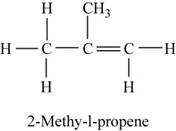
Figure 2
The given reactant reacts with water to form tertiary alcohol as the major product. As tertiary alcohols are formed by the dehydration of
(c)
Interpretation: The structures of the final products formed in the following reactions are to be stated.
Concept introduction: Organic compounds are synthesized through organic reactions. The different types of reactions in organic chemistry are elimination reaction, substitution reaction, addition reactions and many more. Addition reactions are takes place when two or more reactants combine to form a single product. Elimination reactions occur when a reactant broke down into two or more products and the substitution reactions takes place by an exchange in the reactants.
To determine: The two possible structures of C7H12.
(c)
Explanation of Solution
Explanation
The two possible structures of C7H12 are shown in Figure 3.
The two possible structures of C7H12 are,
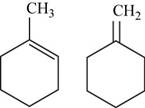
Figure 3
The given chemical formula is C7H12 and the major product formed in the reaction between C7H12 and hydrochloric acid is 1-chloro-1-methylcyclohexane. As the product contains cyclohexane it shows the presence of cyclohexane in the reactant molecule. The reaction between C7H12 and hydrochloric acid is an electrophilic addition reaction which indicate the reactant should possess double bond. Hence, the possible structures of C7H12 for this reaction are shown in Figure 3.
(d)
Interpretation: The structures of the final products formed in the following reactions are to be stated.
Concept introduction: Organic compounds are synthesized through organic reactions. The different types of reactions in organic chemistry are elimination reaction, substitution reaction, addition reactions and many more. Addition reactions are takes place when two or more reactants combine to form a single product. Elimination reactions occur when a reactant broke down into two or more products and the substitution reactions takes place by an exchange in the reactants.
To determine: The structure of hydrocarbon reacted with H2O.
(d)
Explanation of Solution
Explanation
The structure of hydrocarbon is shown in Figure 4.
The structure of hydrocarbon is,
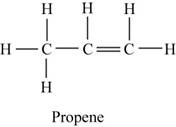
Figure 4
The given hydrocarbon reacts with water which is further oxidized to give acetone. Therefore, the given hydrocarbon should be alkene which is propene as the major product is 2-propanone. Propene first reacts with water to form isopropyl alcohol which is further oxidized to give acetone as the major product.
(e)
Interpretation: The structures of the final products formed in the following reactions are to be stated.
Concept introduction: Organic compounds are synthesized through organic reactions. The different types of reactions in organic chemistry are elimination reaction, substitution reaction, addition reactions and many more. Addition reactions are takes place when two or more reactants combine to form a single product. Elimination reactions occur when a reactant broke down into two or more products and the substitution reactions takes place by an exchange in the reactants.
To determine: The possible structures for C5H12O.
(e)
Explanation of Solution
Explanation
The first possible structure for C5H12O is shown in Figure 5.
The first possible structure for C5H12O is,
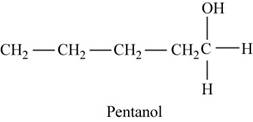
Figure 5
The major product for this reaction is
The second possible structure for C5H12O is shown in Figure 6.
The second possible structure for C5H12O is,
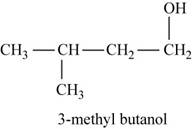
Figure 6
The isomer for the given reactant C5H12O is 3-methylbutanol that is oxidized to give carboxylic acid.
The third possible structure for C5H12O is shown in Figure 7.
The third possible structure for C5H12O is,
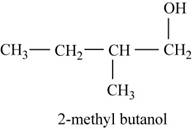
Figure 7
The isomer for the given reactant C5H12O is 2-methylbutanol that is oxidized to give carboxylic acid.
The fourth possible structure for C5H12O is shown in Figure 8.
The fourth possible structure for C5H12O is,
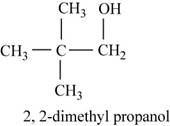
Figure 8
The isomer for the given reactant C5H12O is 2,2-dimethylpropanol that is oxidized to give carboxylic acid.
Want to see more full solutions like this?
Chapter 22 Solutions
Chemistry-Stud. Solution Guide
- Steps and explanation please. Add how to solve or target similar problems.arrow_forwardWould the following organic synthesis occur in one step? Add any missing products, required catalysts, inorganic reagents, and other important conditions. Please include a detailed explanation and drawings showing how the reaction may occur in one step.arrow_forwardThis organic molecule is dissolved in an acidic aqueous solution: OH OH A short time later sensitive infrared spectroscopy reveals the presence of a new C = O stretch absorption. That is, there must now be a new molecule present with at least one C = O bond. In the drawing area below, show the detailed mechanism that could convert the molecule above into the new molecule. Videos 849 Explanation Check C Click and drag to start dwing a structure. # 3 MAR 23 Add/Remove steparrow_forward
- ||| 7:47 ull 57% ← Problem 19 of 48 Submit Curved arrows are used to illustrate the flow of electrons. Use the reaction conditions provided and follow the curved arrows to draw the product of this carbocation rearrangement. Include all lone pairs and charges as appropriate. H 1,2-alkyl shift +arrow_forwardWould the following organic synthesis occur in one step? Add any missing products, required catalysts, inorganic reagents, and other important conditions. Please include a detailed explanation and drawings showing how the reaction may occur in one step.arrow_forwardBelow is the SN1 reaction of (S)-3-chlorocyclohexene and hydroxide (OH). Draw the missing curved arrows, lone pairs of electrons, and nonzero formal charges. In the third box, draw the two enantiomeric products that will be produced. 5th attempt Please draw all four bonds at chiral centers. Draw the two enantiomeric products that will be produced. Draw in any hydrogen at chiral centers. 1000 4th attempt Feedback Please draw all four bonds at chiral centers. 8. R5 HO: See Periodic Table See Hint H Cl Br Jid See Periodic Table See Hintarrow_forward
- Show that a molecule with configuration π4 has a cylindrically symmetric electron distribution. Hint: Let the π orbitals be equal to xf and yf, where f is a function that depends only on the distance from the internuclear axis.arrow_forward(a) Verify that the lattice energies of the alkali metal iodides are inversely proportional to the distances between the ions in MI (M = alkali metal) by plotting the lattice energies given below against the internuclear distances dMI. Is the correlation good? Would a better fit be obtained by plotting the lattice energies as a function of (1 — d*/d)/d, as theoretically suggested, with d* = 34.5 pm? You must use a standard graphing program to plot the graph. It generates an equation for the line and calculates a correlation coefficient. (b) From the graph obtained in (a), estimate the lattice energy of silver iodide. (c) Compare the results of (b) with the experimental value of 886 kJ/mol. If they do not agree, explain the deviation.arrow_forwardCan I please get help with #3 & 4? Thanks you so much!arrow_forward
 ChemistryChemistryISBN:9781305957404Author:Steven S. Zumdahl, Susan A. Zumdahl, Donald J. DeCostePublisher:Cengage Learning
ChemistryChemistryISBN:9781305957404Author:Steven S. Zumdahl, Susan A. Zumdahl, Donald J. DeCostePublisher:Cengage Learning Chemistry: An Atoms First ApproachChemistryISBN:9781305079243Author:Steven S. Zumdahl, Susan A. ZumdahlPublisher:Cengage Learning
Chemistry: An Atoms First ApproachChemistryISBN:9781305079243Author:Steven S. Zumdahl, Susan A. ZumdahlPublisher:Cengage Learning
 General Chemistry - Standalone book (MindTap Cour...ChemistryISBN:9781305580343Author:Steven D. Gammon, Ebbing, Darrell Ebbing, Steven D., Darrell; Gammon, Darrell Ebbing; Steven D. Gammon, Darrell D.; Gammon, Ebbing; Steven D. Gammon; DarrellPublisher:Cengage Learning
General Chemistry - Standalone book (MindTap Cour...ChemistryISBN:9781305580343Author:Steven D. Gammon, Ebbing, Darrell Ebbing, Steven D., Darrell; Gammon, Darrell Ebbing; Steven D. Gammon, Darrell D.; Gammon, Ebbing; Steven D. Gammon; DarrellPublisher:Cengage Learning Introductory Chemistry: A FoundationChemistryISBN:9781337399425Author:Steven S. Zumdahl, Donald J. DeCostePublisher:Cengage Learning
Introductory Chemistry: A FoundationChemistryISBN:9781337399425Author:Steven S. Zumdahl, Donald J. DeCostePublisher:Cengage Learning World of Chemistry, 3rd editionChemistryISBN:9781133109655Author:Steven S. Zumdahl, Susan L. Zumdahl, Donald J. DeCostePublisher:Brooks / Cole / Cengage Learning
World of Chemistry, 3rd editionChemistryISBN:9781133109655Author:Steven S. Zumdahl, Susan L. Zumdahl, Donald J. DeCostePublisher:Brooks / Cole / Cengage Learning





